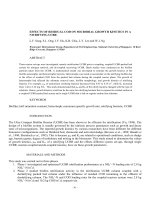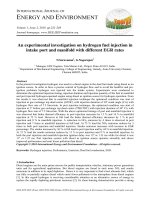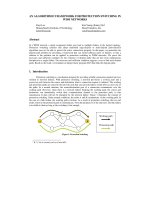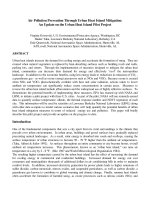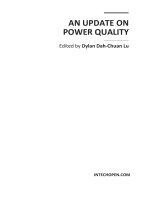AN INEQUALITY ON TERNARY QUADRATIC FORMS IN TRIANGLES
Bạn đang xem bản rút gọn của tài liệu. Xem và tải ngay bản đầy đủ của tài liệu tại đây (343.24 KB, 6 trang )
Volume 10 (2009), Issue 1, Article 15, 6 pp.
AN INEQUALITY ON TERNARY QUADRATIC FORMS IN TRIANGLES
NU-CHUN HU
DEPARTMENT OF MATHEMATICS
ZHEJIANG NORMAL UNIVERSITY
JINHUA 321004, ZHEJIANG
PEOPLE’S REPUBLIC OF CHINA.
Received 07 May, 2008; accepted 25 February, 2009
Communicated by S.S. Dragomir
ABSTRACT. In this short note, we give a proof of a conjecture about ternary quadratic forms
involving two triangles and several interesting applications.
Key words and phrases: Positive semidefinite ternary quadratic form, arithmetic-mean geometric-mean inequality, Cauchy
inequality, triangle.
2000 Mathematics Subject Classification. 26D15.
1. INTRODUCTION
In [3], Liu proved the following theorem.
Theorem 1.1. For any ABC and real numbers x, y, z, the following inequality holds.
(1.1) x
2
cos
2
A
2
+ y
2
cos
2
B
2
+ z
2
cos
2
C
2
≥ yz sin
2
A + zx sin
2
B + xy sin
2
C.
In [6], Tao proved the following theorem.
Theorem 1.2. For any A
1
B
1
C
1
, A
2
B
2
C
2
, the following inequality holds.
(1.2) cos
A
1
2
cos
A
2
2
+ cos
B
1
2
cos
B
2
2
+ cos
C
1
2
cos
C
2
2
≥ sin A
1
sin A
2
+ sin B
1
sin B
2
+ sin C
1
sin C
2
.
Then, in [4], Liu proposed the following conjecture.
Conjecture 1.3. For any A
1
B
1
C
1
, A
2
B
2
C
2
and real numbers x, y, z, the following inequal-
ity holds.
(1.3) x
2
cos
A
1
2
cos
A
2
2
+ y
2
cos
B
1
2
cos
B
2
2
+ z
2
cos
C
1
2
cos
C
2
2
≥ yz sin A
1
sin A
2
+ zx sin B
1
sin B
2
+ xy sin C
1
sin C
2
.
In this paper, we give a proof of this conjecture and some interesting applications.
133-08
2 N C. HU
2. PRELIMINARIES
For ABC, let a, b, c denote the side-lengths, A, B, C the angles, s the semi-perimeter, S
the area, R the circumradius and r the inradius, respectively. In addition we will customarily
use the symbols
(cyclic sum) and
(cyclic product):
f(a) = f(a) + f(b) + f(c),
f(a) = f(a)f (b)f(c).
To prove the inequality (1.1), we need the following well-known proposition about positive
semidefinite quadratic forms.
Proposition 2.1 (see [2]). Let p
i
, q
i
(i = 1, 2, 3) be real numbers such that p
i
≥ 0 (i = 1, 2, 3),
4p
2
p
3
≥ q
2
1
, 4p
3
p
1
≥ q
2
2
, 4p
1
p
2
≥ q
2
3
and
(2.1) 4p
1
p
2
p
3
≥ p
1
q
2
1
+ p
2
q
2
2
+ p
3
q
2
3
+ q
1
q
2
q
3
.
Then the following inequality holds for any real numbers x, y, z,
(2.2) p
1
x
2
+ p
2
y
2
+ p
3
z
2
≥ q
1
yz + q
2
zx + q
3
xy.
Lemma 2.2. For ABC, the following inequalities hold.
2 cos
B
2
cos
C
2
≥
3
√
3
4
sin
2
A > sin
2
A,(2.3)
2 cos
C
2
cos
A
2
≥
3
√
3
4
sin
2
B > sin
2
B,(2.4)
2 cos
A
2
cos
B
2
≥
3
√
3
4
sin
2
C > sin
2
C.(2.5)
Proof. We will only prove (2.3) because (2.4) and (2.5) can be done similarly. Since
S =
1
2
bc sin A =
s(s − a)(s −b)(s − c)
and
cos
B
2
=
s(s − b)
ca
, cos
C
2
=
s(s − c)
ab
,
then it follows that
2 cos
B
2
cos
C
2
≥
3
√
3
4
sin
2
A
⇐⇒ 2
s(s − b)
ca
s(s − c)
ab
≥
3
√
3S
2
b
2
c
2
⇐⇒
4s
2
(s − b)(s −c)
a
2
bc
≥
27s
2
(s − a)
2
(s − b)
2
(s − c)
2
b
4
c
4
⇐⇒
4
a
2
≥
27(s − a)
2
(s − b)(s −c)
b
3
c
3
⇐⇒ 4b
3
c
3
≥ 27a
2
(s − a)
2
(s − b)(s −c).(2.6)
J. Inequal. Pure and Appl. Math., 10(1) (2009), Art. 15, 6 pp. />TERNARY QUADRATIC FORMS IN TRIANGLES 3
On the other hand, by the arithmetic-mean geometric-mean inequality, we have the following
inequality.
27a
2
(s − a)
2
(s − b)(s −c)
= 108 ·
1
2
a(s − a) ·
1
2
a(s − a) ·(s − b)(s − c)
≤ 108
1
2
a(s − a) +
1
2
a(s − a) + (s − b)(s − c)
3
3
= 4
bc −
(b + c −a)
2
4
3
< 4b
3
c
3
.
Therefore the inequality (2.6) holds, and hence (2.3) holds.
Lemma 2.3. For ABC, the following equality holds.
sin
4
A
cos
2
B
2
cos
2
C
2
=
(2R + 5r)s
4
− 2(R + r)(16R + 5r)rs
2
+ (4R + r)
3
r
2
2R
3
s
2
.(2.7)
Proof. By the familiar identity: a + b + c = 2s, ab + bc + ca = s
2
+ 4Rr + r
2
, abc = 4Rrs
(see [5]) and the following identity
a
5
(b + c −a) = −(a + b + c)
6
+ 7(ab + bc + ca)(a + b + c)
4
− 13(a + b + c)
2
(ab + bc + ca)
2
− 7abc(a + b + c)
3
+ 4(ab + bc + ca)
3
+ 19abc(ab + bc + ca)(a + b + c) − 6a
2
b
2
c
2
,
it follows that
a
5
(b + c −a) = 4(2R + 5r)rs
4
− 8(R + r)(16R + 5r)r
2
s
2
+ 4(4R + r)
3
r
3
,
and hence
sin
4
A(1 + cos A) =
a
2R
4
(b + c)
2
− a
2
2bc
=
(a + b + c)
a
5
(b + c −a)
32R
4
abc
=
(2R + 5r)s
4
− 2(R + r)(16R + 5r)rs
2
+ (4R + r)
3
r
2
16R
5
.
Thus, together with the familiar identity
cos
A
2
=
s
4R
, it follows that
sin
4
A
cos
2
B
2
cos
2
C
2
=
sin
4
A cos
2
A
2
cos
2
A
2
=
sin
4
A(1 + cos A)
2
cos
2
A
2
=
(2R + 5r)s
4
− 2(R + r)(16R + 5r)rs
2
+ (4R + r)
3
r
2
2R
3
s
2
.
Therefore the equality (2.7) is proved.
Lemma 2.4. For ABC, the following inequality holds.
(2.8) −(2R + 5r)s
4
+ 2(2R + 5r)(2R + r)(R + r)s
2
− (4R + r)
3
r
2
≥ 0.
J. Inequal. Pure and Appl. Math., 10(1) (2009), Art. 15, 6 pp. />4 N C. HU
Proof. First it is easy to verify that the inequality (2.8) is just the following inequality.
(2.9) (2R + 5r)[−s
4
+ (4R
2
+ 20Rr − 2r
2
)s
2
− r(4R + r)
3
]
+ 2r(14R
2
+ 31Rr − 10r
2
)(4R
2
+ 4Rr + 3r
2
− s
2
)
+ 4(R − 2r)(4R
3
+ 6R
2
r + 3Rr
2
− 8r
3
) ≥ 0.
Thus, together with the fundamental inequality
−s
4
+ (4R
2
+ 20Rr − 2r
2
)s
2
− r(4R + r)
3
≥ 0
(see [5, page 2]), Euler’s inequality R ≥ 2r and Gerretsen’s inequality s
2
≤ 4R
2
+ 4Rr + 3r
2
(see [1, page 45]), it follows that the inequality (2.9) holds, and hence (2.8) holds.
Lemma 2.5. For ABC, the following inequality holds.
(2.10)
sin
4
A
cos
2
B
2
cos
2
C
2
+ 64
sin
2
A
2
≤ 4.
Proof. By Lemma 2.3 and the familiar identity
sin
A
2
=
r
4R
, it follows that
sin
4
A
cos
2
B
2
cos
2
C
2
+ 64
sin
2
A
2
≤ 4
⇐⇒
(2R + 5r)s
4
− 2(R + r)(16R + 5r)rs
2
+ (4R + r)
3
r
2
2R
3
s
2
+
4r
2
R
2
≤ 4
⇐⇒
−(2R + 5r)s
4
+ 2(2R + 5r)(2R + r)(R + r)s
2
− (4R + r)
3
r
2
2R
3
s
2
≥ 0.(2.11)
Thus, by Lemma 2.4, it follows that the inequality (2.11) holds, and hence (2.10) holds.
3. PROOF OF THE MAIN THEOREM
Now we give the proof of inequality (1.1).
Proof. First, it is easy to verify that
cos
A
1
2
cos
A
2
2
≥0,(3.1)
cos
B
1
2
cos
B
2
2
≥0,(3.2)
cos
C
1
2
cos
C
2
2
≥0.(3.3)
Next, by Lemma 2.2, we have the following inequalities:
4 cos
B
1
2
cos
B
2
2
· cos
C
1
2
cos
C
2
2
≥ sin
2
A
1
sin
2
A
2
,(3.4)
4 cos
C
1
2
cos
C
2
2
· cos
A
1
2
cos
A
2
2
≥ sin
2
B
1
sin
2
B
2
,(3.5)
4 cos
A
1
2
cos
A
2
2
· cos
B
1
2
cos
B
2
2
≥ sin
2
C
1
sin
2
C
2
.(3.6)
J. Inequal. Pure and Appl. Math., 10(1) (2009), Art. 15, 6 pp. />TERNARY QUADRATIC FORMS IN TRIANGLES 5
Thus, in order that Proposition 2.1 is applicable, we have to show the following inequality.
(3.7) 4
cos
A
1
2
cos
A
2
2
≥ cos
A
1
2
sin
2
A
1
cos
A
2
2
sin
2
A
2
+ cos
B
1
2
sin
2
B
1
cos
B
2
2
sin
2
B
2
+ cos
C
1
2
sin
2
C
1
cos
C
2
2
sin
2
C
2
+
sin A
1
sin A
2
.
However, in order to prove the inequality (3.7), we only need the following inequality.
(3.8)
sin
2
A
1
cos
B
1
2
cos
C
1
2
·
sin
2
A
2
cos
B
2
2
cos
C
2
2
+
sin
2
B
1
cos
C
1
2
cos
A
1
2
·
sin
2
B
2
cos
C
2
2
cos
A
2
2
+
sin
2
C
1
cos
A
1
2
cos
B
1
2
·
sin
2
C
2
cos
A
2
2
cos
B
2
2
+ 8
sin
A
1
2
· 8
sin
A
2
2
≤ 4.
In fact, by the Cauchy inequality and Lemma 2.5, we have that
sin
2
A
1
cos
B
1
2
cos
C
1
2
·
sin
2
A
2
cos
B
2
2
cos
C
2
2
+
sin
2
B
1
cos
C
1
2
cos
A
1
2
·
sin
2
B
2
cos
C
2
2
cos
A
2
2
+
sin
2
C
1
cos
A
1
2
cos
B
1
2
·
sin
2
C
2
cos
A
2
2
cos
B
2
2
+ 8
sin
A
1
2
· 8
sin
A
2
2
2
≤
sin
4
A
1
cos
2
B
1
2
cos
2
C
1
2
+ 64
sin
2
A
1
2
×
sin
4
A
2
cos
2
B
2
2
cos
2
C
2
2
+ 64
sin
2
A
2
2
≤ 16
Therefore the inequality (3.8) holds, and hence (3.7) holds. Thus, together with inequality
(3.4)–(3.7), Proposition 2.1 is applicable to complete the proof of (1.1).
4. APPLICATIONS
Let P be a point in the ABC. Recall that A, B, C denote the angles, a, b, c the lengths of
sides, w
a
, w
b
, w
c
the lengths of interior angular bisectors, m
a
, m
b
, m
c
the lengths of medians,
h
a
, h
b
, h
c
the lengths of altitudes, R
1
, R
2
, R
3
the distances of P to vertices A, B, C, r
1
, r
2
, r
3
the distances of P to the sidelines BC, CA, AB.
Corollary 4.1. For any ABC, A
1
B
1
C
1
, A
2
B
2
C
2
, the following inequality holds.
a
2
cos
A
1
2
cos
A
2
2
+ b
2
cos
B
1
2
cos
B
2
2
+ c
2
cos
C
1
2
cos
C
2
2
≥ bc sin A
1
sin A
2
+ ca sin B
1
sin B
2
+ ab sin C
1
sin C
2
.
Corollary 4.2. For any ABC, A
1
B
1
C
1
, A
2
B
2
C
2
, the following inequality holds.
w
2
a
cos
A
1
2
cos
A
2
2
+ w
2
b
cos
B
1
2
cos
B
2
2
+ w
2
c
cos
C
1
2
cos
C
2
2
≥ w
b
w
c
sin A
1
sin A
2
+ w
c
w
a
sin B
1
sin B
2
+ w
a
w
b
sin C
1
sin C
2
.
J. Inequal. Pure and Appl. Math., 10(1) (2009), Art. 15, 6 pp. />6 N C. HU
Corollary 4.3. For any ABC, A
1
B
1
C
1
, A
2
B
2
C
2
, the following inequality holds.
m
2
a
cos
A
1
2
cos
A
2
2
+ m
2
b
cos
B
1
2
cos
B
2
2
+ m
2
c
cos
C
1
2
cos
C
2
2
≥ m
b
m
c
sin A
1
sin A
2
+ m
c
m
a
sin B
1
sin B
2
+ m
a
m
b
sin C
1
sin C
2
.
Corollary 4.4. For any ABC, A
1
B
1
C
1
, A
2
B
2
C
2
, the following inequality holds.
h
2
a
cos
A
1
2
cos
A
2
2
+ h
2
b
cos
B
1
2
cos
B
2
2
+ h
2
c
cos
C
1
2
cos
C
2
2
≥ h
b
h
c
sin A
1
sin A
2
+ h
c
h
a
sin B
1
sin B
2
+ h
a
h
b
sin C
1
sin C
2
.
Corollary 4.5. For any ABC, A
1
B
1
C
1
, A
2
B
2
C
2
, the following inequality holds.
R
2
1
cos
A
1
2
cos
A
2
2
+ R
2
2
cos
B
1
2
cos
B
2
2
+ R
2
3
cos
C
1
2
cos
C
2
2
≥ R
2
R
3
sin A
1
sin A
2
+ R
3
R
1
sin B
1
sin B
2
+ R
1
R
2
sin C
1
sin C
2
.
Corollary 4.6. For any ABC, A
1
B
1
C
1
, A
2
B
2
C
2
, the following inequality holds.
r
2
1
cos
A
1
2
cos
A
2
2
+ r
2
2
cos
B
1
2
cos
B
2
2
+ r
2
3
cos
C
1
2
cos
C
2
2
≥ r
2
r
3
sin A
1
sin A
2
+ r
3
r
1
sin B
1
sin B
2
+ r
1
r
2
sin C
1
sin C
2
.
REFERENCES
[1] O. BOTTEMA, R.Ž. DJORDJEVI
´
C, R.R. JANI
´
C, D.S. MITRINOVI
´
C AND P.M. VASI
´
C, Geometric
Inequalities, Wolters-Noordhoff Publishing, Groningen, 1969.
[2] S.J. LEON, Linear Algebra with Applications, Prentice Hall, New Jersey, 2005.
[3] J. LIU, Two results about ternary quadratic form and their applications, Middle-School Mathematics
(in Chinese), 5 (1996), 16–19.
[4] J. LIU, Inequalities involving nine sine (in Chinese), preprint.
[5] D.S. MITRINOVI
´
C, J.E. PE
ˇ
CARI
´
C AND V. VOLENEC, Recent Advances in Geometric Inequal-
ities, Mathematics and its Applications (East European Series), 28. Kluwer Academic Publishers
Group, Dordrecht, 1989.
[6] C.G. TAO, Proof of a conjecture relating two triangle, Middle-School Mathematics (in Chinese), 2
(2004), 43–43.
J. Inequal. Pure and Appl. Math., 10(1) (2009), Art. 15, 6 pp. />
